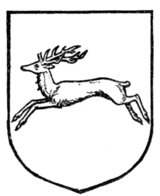STAGS
The stag, using the term in its generic sense, under the various names of stag, deer, buck, roebuck, hart, doe, hind, reindeer, springbok, and other varieties, is constantly met with in British armory, as well as in that of other countries.
In the specialised varieties, such as the springbok and the reindeer, naturally an attempt is made to follow the natural animal in its salient peculiarities, but as to the remainder, heraldry knows little if any distinction after the following has been properly observed. The stag, which is really the male red deer, has horns which are branched with pointed branches from the bottom to the top; but a buck, which is the fallow deer, has broad and flat palmated horns. Anything in the nature of a stag must be subject to the following terms. If lying down it is termed "lodged" (Fig. 379), if walking it is termed "trippant" (Fig. 380), if running it is termed "courant" (Fig. 381), or "at speed" or "in full chase." It is termed "salient" when springing (Fig. 382), though the term "springing" is sometimes employed, and it is said to be "at gaze" when statant with the head turned to face the spectator (Fig. 383); but it should be noted that a stag may also be "statant" (Fig. 384); and it is not "at gaze" unless the head is turned round.






